
Carlo ScarpaTrasparente, 1926-1931
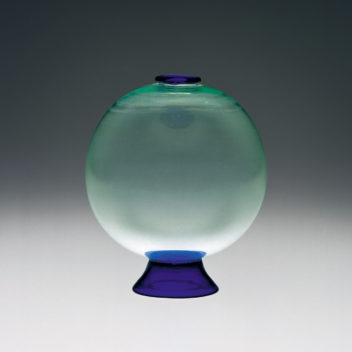
Carlo ScarpaTrasparenteMaestri Vetrai Muranesi Cappellin & C., 1926-1931
Light green globular-shaped vase in blown glass with a conical foot and mouth in blue glass. This vase became the symbol of the M.V.M. Cappellin workshop.
5 1/2 in. high (14 cm)
Exhibitions:
1926, Paris, Salon d’Automne; 1927, Monza, 3rd Mostra Internazionale delle Arti Decorative; 1930, Monza, 4th Mostra Internazionale delle Arti Decorative e Industriali Moderne; 1931, Amsterdam, Exhibition of modern Italian glass, ceramic, and artistic lacework, Stedelijk Museum; 2000, New York, Venetian Glass, Museum of Arts & Design; 2001, Milan, Murano: Vetri dalla Collezione Olnick Spanu, Spazio Oberdan.
Bibliography and comparative texts:
P. du Colombier, 1926, p. 187;
Domus, 1928, December, p. 59;
G. Dell’Oro, 1931, p. 563;
Mostra di vetri…, 1931, p. 19;
Domus, 1933, October, pp. 527, 528, 529;
R. Barovier Mentasti, 1982, p. 260;
Mille anni…, 1982,
p. 262;
Vetri Murano…, 1982, p. 26;
Vetri di Murano…, 1982, n. 106;
F. Deboni, 1996, p. 34;
M. Barovier, 1997, p. 192;
M. Barovier, 1998(b),
p. 6;
M. Barovier, 1999, p. 114;
Olnick Spanu, 2000, n. 18;
Olnick Spanu, 2001, n. 31.
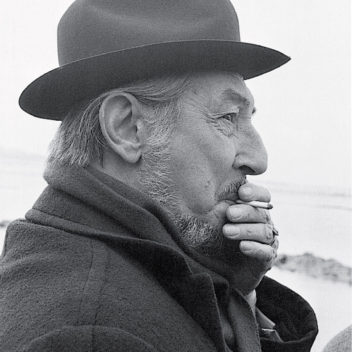
Carlo Scarpa 1906–1978
Born in Venice, Carlo Scarpa graduated from the Accademia di Belle Arti in Venice in 1926. Soon after his graduation he began work at M.V.M. Cappellin, where he soon replaced Vittorio Zecchin as artistic director. Following the direction laid down by Zecchin, he initially created transparent blown-glass pieces with essential forms, in particular the pieces exemplified by their conic base. Scarpa later designed light glass pieces in brightly colored pasta vitrea, or decorated fenici. Deservedly famous was the refined collection of lattimi decorated with gold or silver leaf, which he presented for the first time in Monza in 1930 together with the canne verticali and millefiori glass works. Giacomo Cappellin closed the workshop in 1932 for bankruptcy, putting an end to the collaboration with Carlo Scarpa. In 1934, Scarpa became the artistic director of Venini & C., where he continued to work through 1947. Alongside Paolo Venini, who often participated in the design of glass, Carlo Scarpa experimented with the vast potential of glass, using and innovating many traditional techniques, by which he created extraordinary modern pieces. After the mezza filigrana glass works came the sommersi, the pasta vitrea inspired by Chinese ceramic motifs, the corrosi, the battuti, the vessels a fasce colorate, a pennellate, the variegati, and the famous multicolored murrine with the surfaces finished at the carving wheel. After World War II, Carlo Scarpa worked almost exclusively as an architect and teacher.
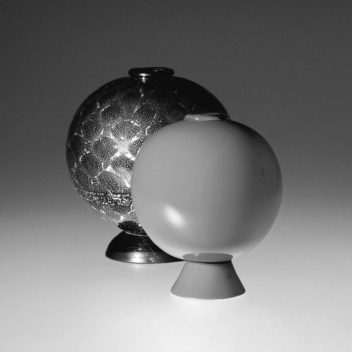
Maestri Vetrai Muranesi Cappellin & C. 1925–1932
M.V.M. Cappellin & C. was founded in 1925 by Giacomo Cappellin after the closing of Cappellin Venini & C. Vittorio Zecchin, a painter from Murano who had worked for Cappellin Venini, continued his collaboration with Cappellin for a short time, designing soffiati, blown glass pieces characterized by delicate colors and pure lines. At the end of 1926, following Zecchin's departure, the young Carlo Scarpa took over the artistic direction of the company. Initially, he proceeded along the course taken by his predecessor, creating lightweight blown pieces with simple geometric forms. These were followed by many collections of refined elegance characterized by various transparent textures and often distinguished by vivid colors. Despite the remarkable success at the 1930 Biennale di Monza, M.V.M. Cappellin & C. was forced to close in January 1932. This was most likely the result of inefficient financial management.
Carlo ScarpaTrasparente, 1926-1931

Mary Ann ZynskyFolto, 1984
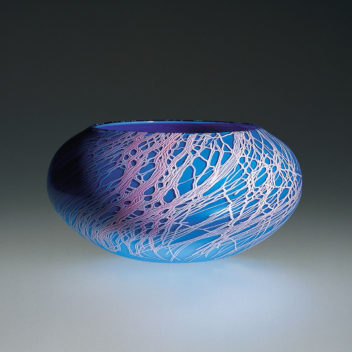
Mary Ann ZynskyFoltoVenini & C., 1984
A bowl composed of cased blue glass decorated with an irregular application of pink glass threads.
Engraved: Zinsky x Venini 1984.
5 in. high (12.7 cm)
Exhibitions:
2000, New York, Venetian Glass, Museum of Arts & Design;
2001, Milan, Murano: Vetri dalla Collezione Olnick Spanu, Spazio Oberdan.
Bibliography and comparative texts:
A. Venini Diaz de Santillana, 1996, n. 262;
M. Barovier, 1999, p. 317;
A. Venini Diaz de Santillana, 2000, n. 269;
Olnick Spanu, 2000, n. 154;
Olnick Spanu, 2001, n. 191.
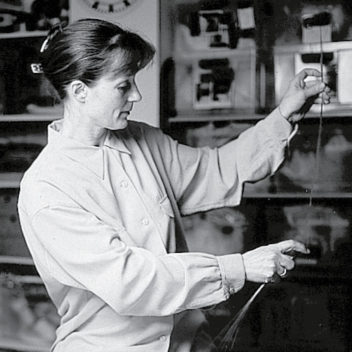
Mary Ann Zynsky 1951–
Designer Mary Ann "Toots" Zynsky was born in Boston and attended the Rhode Island School of Design, the Pilchuck Glass School, and the Craft School at Haystack, taking part in various experiences and experiments. From 1981 to 1983, she collaborated with Venini, where, with the help of maestro Checco Ongaro, she created a remarkable series of pieces. Among these are the vessels called Folto, whose openings have wide turned-over lips, and decorations with glass rods produced out of hair-thin threads made with a technique she invented herself. Her works are present not only in the major international museums, but also in the White House amidst the works of the best American artists.

Venini & C. 1932–2001
In 1932, when both Martinuzzi and Zecchin left the company, Paolo Venini changed the name from Vetri Soffiati Muranesi Venini & Co. (V.S.M. Venini & Co.) to Venini & C.. Milanese architect Tommaso Buzzi became the new artistic director. After 1934, artistic direction was taken on by Carlo Scarpa, who designed most of the company's production through 1947. Side by side with Venini, who often intervened personally in design, Scarpa created numerous collections of objects characterized by refined colors. After World War II, Venini & C. sought numerous collaborations with artists such as architect Giò Ponti and the Swedish-born Tyra Lundgren. After 1948, Fulvio Bianconi, Massimo Vignelli, and Tobia Scarpa contributed significantly to the new direction of the company. Paolo Venini died in 1959 and his son-in-law, Ludovico Diaz de Santillana, took over the management of Venini & C. He not only worked personally as a glass designer but also continued the collaboration started by Paolo Venini with various artists and designers. Starting in 1960, many other designers collaborated with the company, like Thomas Stearns, Toni Zuccheri, Tapio Wirkkala, Laura and Alessandro Diaz de Santillana, James Carpenter, Dan Dailey, Richard Marquis, Benjamin Moore, and Toots Zynsky. In 1986, the de Santillana family left the company, selling their stock to the Ferruzzi group, which guaranteed the fine quality Venini was known for by hiring new designers such as Timo Sarpaneva, Marco Zanini, Ettore Sottsass Jr., Alessandro Mendini, Mario Bellini, Barbara del Vicario, and others. In 1988, Venini was acquired by Royal Scandinavian. Since 2001, Venini S.p.A. has been part of Italian Luxury Industries Group and is led by Giancarlo Chimento, Giuliano Tabacchi, and Giorgio Rizzo.
Mary Ann ZynskyFolto, 1984
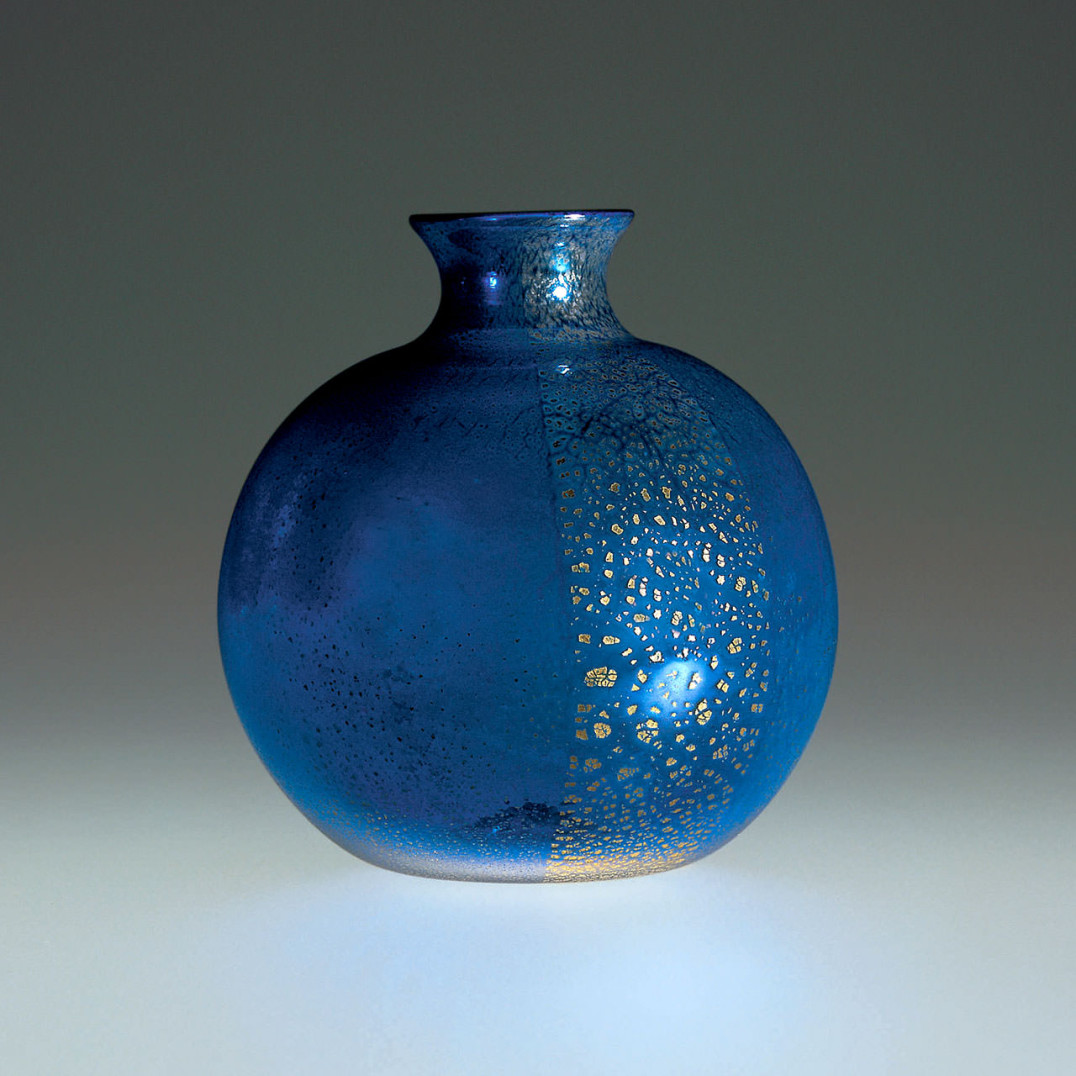
Carlo ScarpaTrasparente, 1926-1931
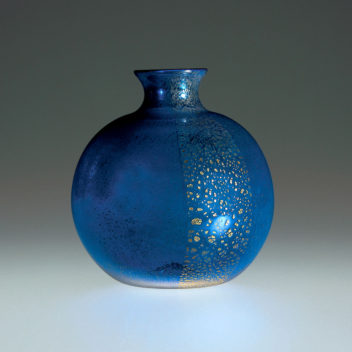
Carlo ScarpaTrasparenteMaestri Vetrai Muranesi Cappellin & C., 1926-1931
Vessel in transparent blue glass decorated with applications of
gold leaf.
5 7/8 in. high (15 cm)
Exhibitions:
1926, Paris, Salon d’Automne;
1927, Monza, 3th Mostra Internazionale delle Arti Decorative;
1930, Monza, 4th Mostra Internazionale delle Arti Decorative e Industriali Moderne;
1931, Amsterdam, Exhibition of modern Italian glass, ceramic, and artistic lacework, Stedelijk Museum;
2001, Milan, Murano: Vetri dalla Collezione Olnick Spanu, Spazio Oberdan.
Bibliography and comparative texts:
P. Du Colombier, 1926, p. 187;
Domus, 1928, December, p. 59;
G. Dell’Oro, 1931, p. 563;
Mostra di vetri…, 1931, p. 19;
Domus, 1933, October, pp. 527-529;
R. Barovier Mentasti, 1982, p. 260;
Mille anni…, 1982, p. 262;
Vetri Murano…, 1982, p. 26;
Vetri di Murano…, 1982, n. 106;
F. Deboni, 1996, p. 34;
M. Barovier, 1997, p. 192;
M. Barovier, 1998 (a), p. 6;
M. Barovier, 1999, p. 114;
Olnick Spanu, 2001, n. 32.

Carlo Scarpa 1906–1978
Born in Venice, Carlo Scarpa graduated from the Accademia di Belle Arti in Venice in 1926. Soon after his graduation he began work at M.V.M. Cappellin, where he soon replaced Vittorio Zecchin as artistic director. Following the direction laid down by Zecchin, he initially created transparent blown-glass pieces with essential forms, in particular the pieces exemplified by their conic base. Scarpa later designed light glass pieces in brightly colored pasta vitrea, or decorated fenici. Deservedly famous was the refined collection of lattimi decorated with gold or silver leaf, which he presented for the first time in Monza in 1930 together with the canne verticali and millefiori glass works. Giacomo Cappellin closed the workshop in 1932 for bankruptcy, putting an end to the collaboration with Carlo Scarpa. In 1934, Scarpa became the artistic director of Venini & C., where he continued to work through 1947. Alongside Paolo Venini, who often participated in the design of glass, Carlo Scarpa experimented with the vast potential of glass, using and innovating many traditional techniques, by which he created extraordinary modern pieces. After the mezza filigrana glass works came the sommersi, the pasta vitrea inspired by Chinese ceramic motifs, the corrosi, the battuti, the vessels a fasce colorate, a pennellate, the variegati, and the famous multicolored murrine with the surfaces finished at the carving wheel. After World War II, Carlo Scarpa worked almost exclusively as an architect and teacher.

Maestri Vetrai Muranesi Cappellin & C. 1925–1932
M.V.M. Cappellin & C. was founded in 1925 by Giacomo Cappellin after the closing of Cappellin Venini & C. Vittorio Zecchin, a painter from Murano who had worked for Cappellin Venini, continued his collaboration with Cappellin for a short time, designing soffiati, blown glass pieces characterized by delicate colors and pure lines. At the end of 1926, following Zecchin's departure, the young Carlo Scarpa took over the artistic direction of the company. Initially, he proceeded along the course taken by his predecessor, creating lightweight blown pieces with simple geometric forms. These were followed by many collections of refined elegance characterized by various transparent textures and often distinguished by vivid colors. Despite the remarkable success at the 1930 Biennale di Monza, M.V.M. Cappellin & C. was forced to close in January 1932. This was most likely the result of inefficient financial management.
Carlo ScarpaTrasparente, 1926-1931
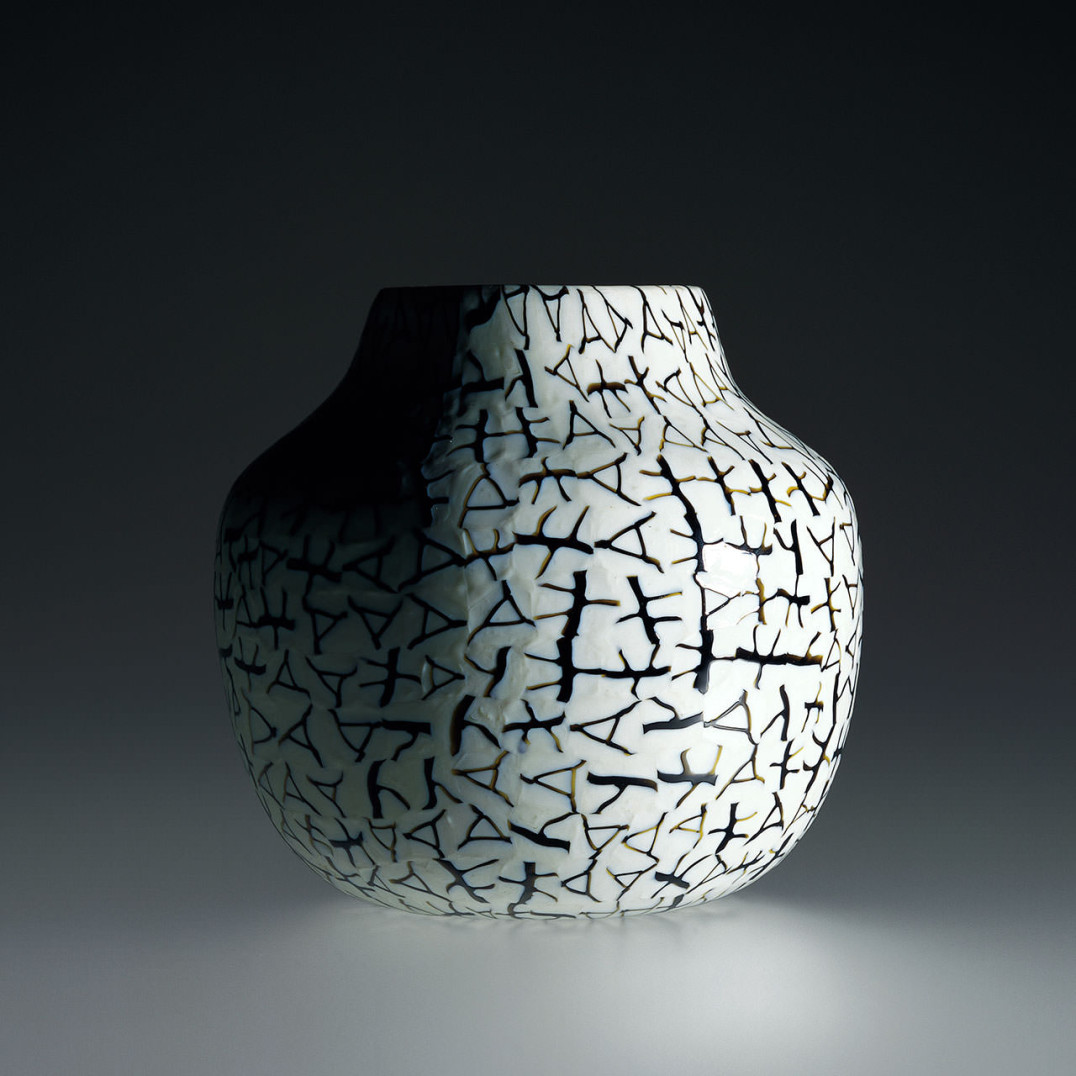
Alessandro Diaz de SantillanaCoccio, 1984
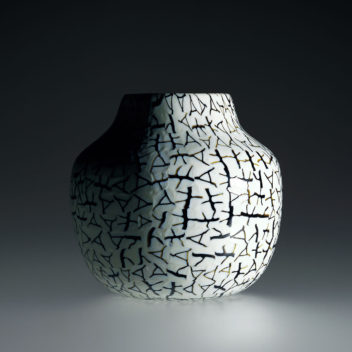
Alessandro Diaz de SantillanaCoccioVenini & C., 1984
A white vase composed of lattimo murrine decorated with an abstract pattern of black glass and finished with the applications of gold leaf.
7 in. high (17.8 cm)
Exhibitions:
2000, New York, Venetian Glass, Museum of Arts & Design;
2001, Milan, Murano: Vetri dalla Collezione Olnick Spanu, Spazio Oberdan.
Bibliography and comparative texts:
A. Venini Diaz de Santillana, 1996, n. 261;
Venini Venezia, 1998, p. 79;
A. Venini Diaz de Santillana, 2000, n. 267;
Olnick Spanu, 2000, n. 152;
Olnick Spanu, 2001, n. 190.
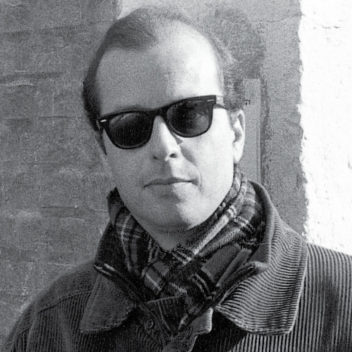
Alessandro Diaz de Santillana 1959–
Born in Paris of Venetian origin, Alessandro Diaz de Santillana graduated in Art History at the Università di Venezia in 1981. At Venini & C., founded by his grandfather, Paolo Venini, and managed by his father, Ludovico Diaz de Santillana, he had the opportunity to meet many artists from the American Studio Glass movement who worked at the furnace thanks to the openness and generosity of the artistic director. He collaborated with Venini & C. through 1985, and later with Rosenthal and Eos. He has been exhibiting since 1985, after choosing to progressively dedicate himself to his own personal artistic development and to the creation of original works.

Venini & C. 1932–2001
In 1932, when both Martinuzzi and Zecchin left the company, Paolo Venini changed the name from Vetri Soffiati Muranesi Venini & Co. (V.S.M. Venini & Co.) to Venini & C.. Milanese architect Tommaso Buzzi became the new artistic director. After 1934, artistic direction was taken on by Carlo Scarpa, who designed most of the company's production through 1947. Side by side with Venini, who often intervened personally in design, Scarpa created numerous collections of objects characterized by refined colors. After World War II, Venini & C. sought numerous collaborations with artists such as architect Giò Ponti and the Swedish-born Tyra Lundgren. After 1948, Fulvio Bianconi, Massimo Vignelli, and Tobia Scarpa contributed significantly to the new direction of the company. Paolo Venini died in 1959 and his son-in-law, Ludovico Diaz de Santillana, took over the management of Venini & C. He not only worked personally as a glass designer but also continued the collaboration started by Paolo Venini with various artists and designers. Starting in 1960, many other designers collaborated with the company, like Thomas Stearns, Toni Zuccheri, Tapio Wirkkala, Laura and Alessandro Diaz de Santillana, James Carpenter, Dan Dailey, Richard Marquis, Benjamin Moore, and Toots Zynsky. In 1986, the de Santillana family left the company, selling their stock to the Ferruzzi group, which guaranteed the fine quality Venini was known for by hiring new designers such as Timo Sarpaneva, Marco Zanini, Ettore Sottsass Jr., Alessandro Mendini, Mario Bellini, Barbara del Vicario, and others. In 1988, Venini was acquired by Royal Scandinavian. Since 2001, Venini S.p.A. has been part of Italian Luxury Industries Group and is led by Giancarlo Chimento, Giuliano Tabacchi, and Giorgio Rizzo.
Alessandro Diaz de SantillanaCoccio, 1984
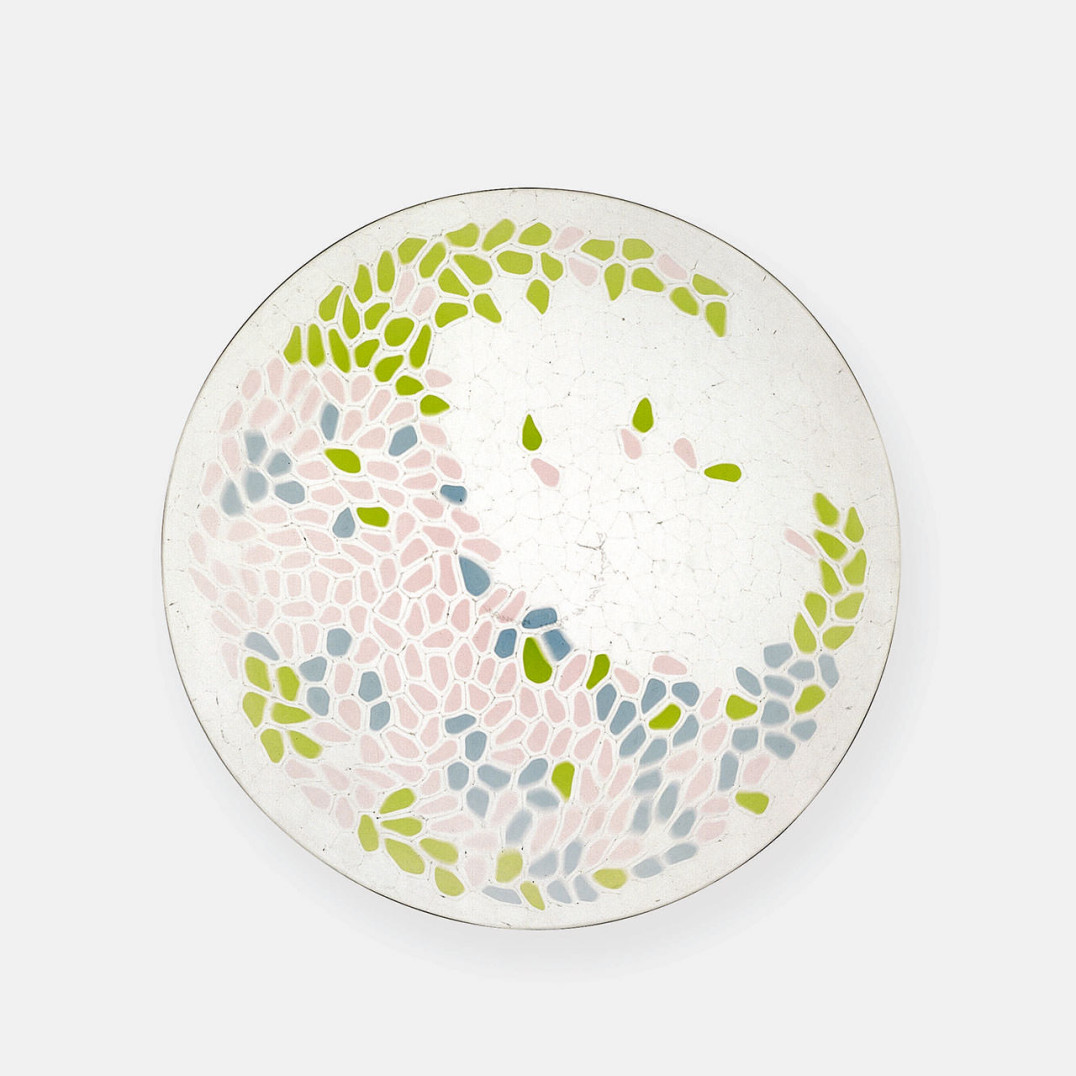
Laura Diaz de SantillanaGlicine, 1979
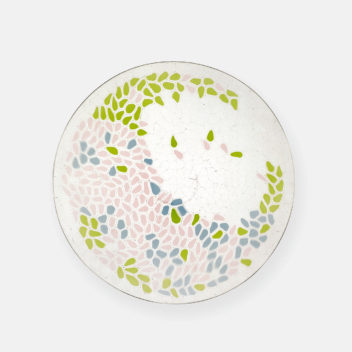
Laura Diaz de SantillanaGlicineVenini & C., 1979
A plate with cristallo, yellow, amethyst, and blue pale murrine arranged to replicate a wisteria pattern.
Engraved: venini italia 79 100/3 Laura.
Ø; 10 5/8 in. (27 cm)
Exhibitions:
2000, New York, Venetian Glass, Museum of Arts & Design;
2001, Milan, Murano: Vetri dalla Collezione Olnick Spanu, Spazio Oberdan.
Bibliography and comparative texts:
A. Venini Diaz de Santillana, 1996, n. 255;
A. Venini Diaz de Santillana, 2000, n. 262;
Olnick Spanu, 2000, n. 151;
Olnick Spanu, 2001, n. 189.
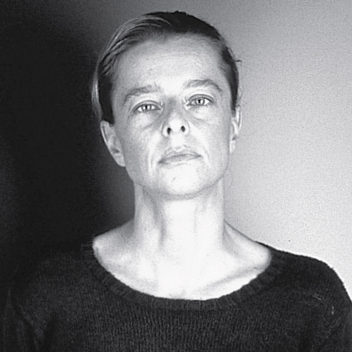
Laura Diaz de Santillana 1955–
Born in Venice, Laura Diaz de Santillana attended the School of Visual Arts in New York. After working as a graphic designer at the design firm of Vignelli Associates in 1976, she returned to Italy and began an active collaboration with Vetreria Venini & C., founded by her grandfather, Paolo Venini. At the workshop, managed with a spirit of great openness by her father, Ludovico Diaz de Santillana, her work brought her in close contact with the many Italian and foreign artists who came to the furnace in those years. During that period, she used the techniques of Murano to create refined works with unusual colors, among which the plates in vetro mosaico deserve particular mention. From 1985 to 1993, she was the designer and artistic director of Eos and later worked as designer for Rosenthal and for Ivan Baj. Further developing her own artistic identity through the creation of original works, lately she has focused her attention on the sculptural qualities of the material, which is often finished in singular textures. De Santillana's meditated study of color has produced original solutions. She has participated in numerous exhibitions in Europe, the United States, and Japan, winning widespread consensus. Several of her works have been acquired by public and private collections such as the Corning Museum of Glass, the Museum für Kunst und Gewerbe in Hamburg, and the Museo Vetrario di Murano.

Venini & C. 1932–2001
In 1932, when both Martinuzzi and Zecchin left the company, Paolo Venini changed the name from Vetri Soffiati Muranesi Venini & Co. (V.S.M. Venini & Co.) to Venini & C.. Milanese architect Tommaso Buzzi became the new artistic director. After 1934, artistic direction was taken on by Carlo Scarpa, who designed most of the company's production through 1947. Side by side with Venini, who often intervened personally in design, Scarpa created numerous collections of objects characterized by refined colors. After World War II, Venini & C. sought numerous collaborations with artists such as architect Giò Ponti and the Swedish-born Tyra Lundgren. After 1948, Fulvio Bianconi, Massimo Vignelli, and Tobia Scarpa contributed significantly to the new direction of the company. Paolo Venini died in 1959 and his son-in-law, Ludovico Diaz de Santillana, took over the management of Venini & C. He not only worked personally as a glass designer but also continued the collaboration started by Paolo Venini with various artists and designers. Starting in 1960, many other designers collaborated with the company, like Thomas Stearns, Toni Zuccheri, Tapio Wirkkala, Laura and Alessandro Diaz de Santillana, James Carpenter, Dan Dailey, Richard Marquis, Benjamin Moore, and Toots Zynsky. In 1986, the de Santillana family left the company, selling their stock to the Ferruzzi group, which guaranteed the fine quality Venini was known for by hiring new designers such as Timo Sarpaneva, Marco Zanini, Ettore Sottsass Jr., Alessandro Mendini, Mario Bellini, Barbara del Vicario, and others. In 1988, Venini was acquired by Royal Scandinavian. Since 2001, Venini S.p.A. has been part of Italian Luxury Industries Group and is led by Giancarlo Chimento, Giuliano Tabacchi, and Giorgio Rizzo.